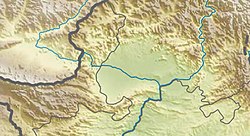Hund, Khyber Pakhtunkhwa (original) (raw)
(Redirected from Hund (village))
Village in Khyber Pakhtunkhwa, Pakistan
Hund
| هنډ | |
|---|---|
 Buddhist Devata statue from Hund, 6-7th century AD. Museum of Oriental Art (Turin). Buddhist Devata statue from Hund, 6-7th century AD. Museum of Oriental Art (Turin). |
|
     |
|
| Coordinates | 34°01′00″N 72°26′00″E / 34.016667°N 72.433333°E / 34.016667; 72.433333 |
| Type | Monastery |
Hund (Pashto: هنډ), known in antiquity as Udabhandapura,[1] is a small village in Swabi district, situated on the right bank of the Indus River in the Khyber Pakhtunkhwa province of Pakistan. It is about 15 km upstream of Attock Fort and is located 80 km to the east of Peshawar.
It was the site of Alexander the Great's crossing of the Indus in 327 BC, and an important site of Gandhara ruins.[2] It is also the site of Hund Museum.
It was Turk Shahi capital of Gandhara, which possibly functioned as a winter capital alternating with the summer capital of Kabul, within their kingdom of Kapisa-Gandhara in the 7-9th century AD.[3]
Hund was also the last capital of Gandhara, following Charsadda (then Pushkalavati) and Peshawar (then known as Purushapura), under the Hindu Shahi rulers until the beginning of 11th century AD, when Mahmud of Ghazni defeated Anandapala, the last Hindu Shahi ruler in Gandhara. The Hindu Shahi capital was then shifted to Nandana in the Salt Range, Punjab.[4] It has also been said that the Mongol invader Genghis Khan also followed Khwarezm Shah up to Hund, before the prince jumped into the Indus River on his way to India.[5]
The village Hund is surrounded by a fort, remains of which are still visible. There were four gates of the walled city which are visible till to date and were used as entry and exit points. It is said that of the walled city a deep trench was also dug to control un authorized entry. The trench was crossed by a movable wooden bridge which used to be lifted at night by the guards of the gates and Garrison closed at night. According to some historians there was a tunnel inside the walled city which connected Hund Garrison with Attock Fort so that both Garrisons can reinforce each other in case of attack and used the tunnel as a withdrawal route in case a Garrison fell into enemy hands.
Old relics and remains of ancient civilizations have been found in the village after excavation work was undertaken by the government in recent past. The history and past glory of the Hund has been preserved by the govt by constructing a museum in the village on the bank of river Indus. A replica of tower of Olympia has also been constructed watching the mighty Indus in the memory of Alexander the Great who crossed river Indus and stayed in Hund during his last military campaign of the Indian sub continent.
Before Pak India partition, the village was a mixture of Hindu and Muslim population. Remains of Hindu worship places, their residences etc were visible till near past , however same are now nearly non existent after increase in population. After partition most of the nonuslims left for india. Now the village was mainly inhibited by Pathans who later on invited artisans from other clans and casts to settle down in the village so as to make it an independent entity. The settlements of Balar Khel are mainly in villages Zaida, Maini, Yaqubi, Yar Hussain, Hund, Ambar, Lahor, Kaddi and Panj Pir in Swabi District of Khyber Pakhtunkhwa in Pakistan. Hund has also the unique honour to be the capital of a Hindu Maharaja and a military Garrison of Akbar the According to Historians Hund is one the oldest city in earth surviving till to date.

Buddhist Devata statue from Hund, 6-7th century AD. Museum of Oriental Art (Turin)
Buddhist Devata, 6-7th century AD, Hund. Museum of Oriental Art (Turin)- Hund Museum
- Takht Bhai
- ^ "Excavation sought in Pak's Hund,capital of Hindu Shahi dynasty". Business Standard. 27 March 2016.
- ^ "KP govt to promote heritage, archeology tourism". The News International. 8 December 2020. Retrieved 11 July 2022.
- ^ "The capital of the state of Kapisa–Gandhara (possibly, its winter capital) was Udabhandapura, now the settlement of Hund, situated on the right bank of the Kabul river. Most of the city was surrounded by a defensive rampart." in Harmatta, J.; Litvinsky, B. A. (1992). History of Civilizations of Central Asia: Tokharistan and Gandhara under Western Türk Rule (650-750). Unesco. p. 391. ISBN 978-92-3-103211-0.
- ^ "Cafeteria, rest house inaugurated at Hund Museum". The News International. 7 January 2009. Archived from the original on 6 January 2019. Retrieved 11 July 2022.
- ^ Ali, Manzoor (1 January 2012). "Lost glory: In Hund, retracing the steps of history". The Express Tribune. Retrieved 11 July 2022.

